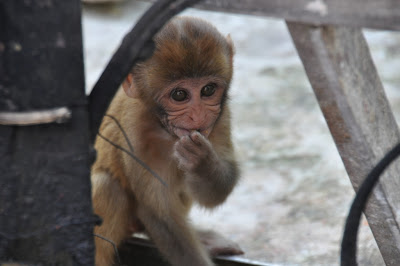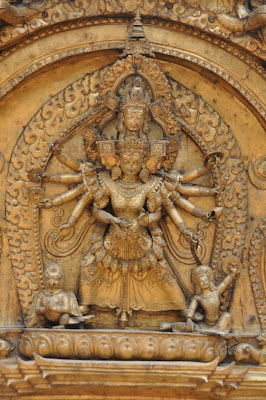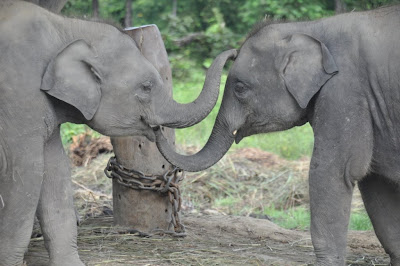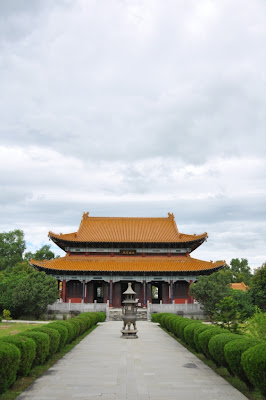The second leg of the trip home began for us in Kathmandu, capital of Nepal. Technically still Asia, but it’s the sub-continent so enough for us to consider it a new stage, especially when you consider the time-zone change. Now everyone knows that Adelaide likes to make life difficult for itself by having a time zone that is unusually offset by nine and a half hours from GMT, a quirk that many Adelites are quite proud of. But Adelaide step aside, for Nepal has usurped your position as ‘King of the Quirky Time-Zone’ and is offset from GMT by 5 and three quarter hours. Try looking at your watch now and working out what time it is in New Zealand...
We’ve been on the road now for a week short of two months and going through the motions of checking in at an airport and passing through immigration helps us to separate this part of our travels from south-east Asia. The familiarity of the airport check-in and security routine re-invigorated us for more adventures, whilst in-flight entertainment was a particular welcome addition though the flight was too short to really take advantage of this piece of normality (though we did manage to take in the latest thought provoking offering by Joe Carnahan - ‘The A Team’).
Our arrival into Kathmandu certainly told us we were somewhere new – surrounded by people touting their taxi option and invading our personal space, we weren’t sure that this was the same Kathmandu that Sir Edmund Hillary flew into so many times over the years. If there is room in the entertainment industry for a ‘Third-World World’ theme park, then the taxi-ride from Kathmandu airport would feature well as a thrill-ride. The roads consist of a series of inter-connected pot-holes and quarter finished road works projects, while mini-vans and cycle rickshaws obey strictly the Nepalese road code which has one rule – eat or be eaten. Goats and cows proliferate the roads while even now, a week on from arrival, we’re not sure if you drive on the left or right hand side of the road.
In Kathmandu we ticked the sights off in a now routine manner, beginning with the walking tour through the hive of commerce that is the Thamel district, before taking in the beautiful Durbar Square and Swayambhunath Buddhist temple. All very different and interesting in their own way, Swayambhunath leaves a lasting impression for the commanding view over Kathmandu, the monkey’s that at time out-number the visitors and the small insight into the Buddhist religion. As always though, where there are swings there are roundabouts and every corner turned in Kathmandu revealed a new tout to annoy us in the moment. And as has always been the case on our travels, Mat was offered drugs at every turn (what is it about Mat that screams ‘offer me drugs’ – sunscreen yes, but drugs?).











The view over Kathmandu from the monkey temple.

As we seem to do, we bumped into another military demonstration of some description. This one involved nearly a thousand troops performing gun drills in a square formation. Note the line is not the straightest...
Our time in Nepal was always going to be short and hopes of completing the trek to Everest Base Camp had to be shelved early on due to the timing of our arrival in Nepal, the late monsoon and the limited time before we head to Africa. We did however head west of Kathmandu to visit Bhaktapur en route to the mountain top town of Nargakot where the chance of a view of the Himalayas and a mountain walk (ramble for those standing members of the CJRC) awaited. Our journey west saw us re-introduced to local buses which for a one hour journey broke the bank at 20p cost. The journey was akin to the ride from the airport with the option of sitting on the roof of the bus (which we declined upon review of the travel insurance policy – in ‘Third World World’ the rooftop option would be available to those with premium entrance tickets).
Bhaktapur is one of the best preserved medieval city-states in the Kathmandu (Lonely Planet, 2009) and certainly impressed. Buddhist shrines and temples, public squares, markets and a royal palace make for a great wander round the streets of the city. We also found a great wee spot for lunch where we got stuck into the Mo Mo’s, a Nepalese/Tibetan take on dumplings that never disappointed. The chilli option brought out a nice cleansing sweat as well.
Bhaktapur is one of the best preserved medieval city-states in the Kathmandu (Lonely Planet, 2009) and certainly impressed. Buddhist shrines and temples, public squares, markets and a royal palace make for a great wander round the streets of the city. We also found a great wee spot for lunch where we got stuck into the Mo Mo’s, a Nepalese/Tibetan take on dumplings that never disappointed. The chilli option brought out a nice cleansing sweat as well.







We stumbled onto some religious ceremony during the wander, so naturally fired off some photos.
From Bhaktapur we carried on westward to Nagarkot, a small village at 2,200 metres with sweeping vistas of the Himalayas at the right time of year. Now emphasis has to be placed on the latter point, with the right time of year being October through March, earlier only if the monsoon has passed. In 2010, we can advise that the monsoon was a month late in arriving, and thus our chances of a view were slim at best given the weather forecast. Ever the optimists, we headed forth and arrived in the early evening to around 100m visibility as Nagarkot was shrouded in cloud. Still 12 hours till sunrise as we checked into our electricity-less little mountain bungalow.
We arose at 5.30am to very different weather conditions, with visibility reduced to 50m, and thus we believed our plan to sneak a glimpse of the mighty peaks to have been thwarted. We decided to get up anyway and walk round the ridgeline in case there was any change in conditions, and were rewarded with 90 minutes of climatic conditions that even Jim Hickey would fail to explain (though, a famous quote of his does come to mind – “By sunrise the bad weather will be gone-burger and the good weather will be come-burger.” - do not google this though). From about 6am onwards, the cloud started to roll back, and by 6.30 am there were two distinct layers unfurled in front of us – a lower base of cloud that covered the valley floor from 1,000m and an upper layer at about 10,000m, leaving a thin window of view towards the mountains. Over the space of 30 minutes we were rewarded with a distant view of the Himalayas that confirmed all previous thoughts about needing to return at some stage in the future with time up our sleeves to trek. To the far east where the sun was rising, Everest could just be made out, which marked an end of a long line of peaks on the horizon. Our photos do not do the view justice, and within 20 minutes of it being revealed the cloud started to roll back in, reminding us it was September and not October.

The Wicked Campers Nepal advertising shot would have to await a break in the weather.



Thank God for the 18mm - 270mm zoom range.

Believe it or not, the very small peak to the right of the blobby peak directly above the word 'blobby' in this photo description is Mount Everest (Geographic description courtesy of Mat Bartholomew, M.Sc (Geography), Sir Neil Isaac Scholar in the Environmental Sciences (2001-2002) and George Jobberns Prize for B E science thesis 2002).


Following sunrise, we discovered this interesting piece of building work. We expect the builder was very proud when he reported that he'd finished the front of the house.
After the sunrise, we walked the ridgeline to the summit of Nagarkot where a viewing platform awaited. Fingers were crossed that the weather may miraculously clear as it had done just after sunrise, but it was not to be (two views of Everest in one day would have been a bit greedy!). Caroline waited out for a change in the weather with a crossword which she’d started working on in Chiang Mai, and by the time we returned to Kathmandu she had it down to 5 clues left (anyone know the answer to 50 across, clue ‘more precipitous’, seven letters, something t e something p something). The walk back also entailed a chance meeting with a snake which, after a couple of girly pokes with a long stick, Mat was able to confirm was quite dead and unlikely to pose a threat.

Yes, Mary had a little lamb (singular), but Caroline of Nagarkot had some little goats. Followed us for 30 minutes.

The sweeping vista of the Himalayas.

Operation ‘One Week Nepal’ then shifted south to Chitwan National Park, where we hoped to get some pre-Africa safari training in. And while our arrival in Kathmandu had been full on, this had nothing on the arrival we had at Chitwan bus-park, which is a gravel car park a few kilometres from the park entrance. Exiting the bus, we were surrounded by 20-30 taxi touts working on behalf of different jungle lodges. There was shouting, invasion of personal space, touching, some spittle, grabbing and even a small fracas amongst the touts. I can only liken it to the media scrum that awaited David Bain when he was first released from jail in a God-awful home knitted jersey.


Our first foray into Chitwan National Park was to head down river in a dug-out canoe, before walking through the grasslands and jungle for a few hours. Did we mention the monsoon has arrived late this year? Almost upon queue, the rain started to fall as soon as we sat in our dug-out canoe. While the walk was a little uncomfortable in the rain, we were rewarded with a short view of a couple of young rhinos by a watering hole. The one-horned rhino of the Chitwan are very distinctive, with their bodies made up of what appears to be three pieces of armour platelet, giving them a very prehistoric appearance more akin to a dinosaur than anything else we’ve ever seen.

Sneaking a peak from amongst the foliage - very very intrepid.

The jungle walk finished at an elephant breeding centre (we didn't stick round to watch the breeding though). These two are the only twin elephants ever born through a breeding program.
It was on this jungle walk that we were introduced to leeches. Our man at our lodge that had booked us in for the jungle walk had said wear trousers and a long sleeved top. Neither of us are in procession of long trousers and we weren’t too worried about getting some mud on our legs, but 100 metres into the jungle walk we realised the trousers and long sleeves were a preventative measure against the leeches. We were ever vigilant, keeping a close eye on our exposed skin for any sign of leeches and by the end of the walk, between us we’d successfully thwarted three leech attacks – two on Caros and one on Mat.
This became a bit of a source of humour amongst the group, as it transpired the two people least prepared for leeches emerged from the jungle unscathed, whilst the two who had every piece of flesh covered by a ‘North Face’ garment of some description both discovered several leeches on themselves during the walk and again once we emerged from the jungle, all of which were well fed and had made homes around the elastic band line of their scunges.
After the jungle walk, we rested up at our lodge, only for the hoped for sights of the jungle walk to come to us. First of all, an old one horn rhino emerged on the bank of the river, 100 metres from our lodgings and mused about for an hour. Growing tired of the rhino, we headed back to our room, only to find an endangered Gharial crocodile had made residence on the river bank across from our lodge. It was while photographing this croc that Mat let his guard down and soon found himself with a leech happily feeding away on his leg. It took quite a bit of effort to remove it, but the scarring should be minimal. This also put Mat on top of the leech count by virtue of the tie breaker rule (we were tied 2 all at this stage) which said a bleeder was worth a bonus point. Then, to top it all off, a local pulled in to say hello to us while we ate lunch and to show us the python he’d just found and was taking to the conservation office to relocate.
This became a bit of a source of humour amongst the group, as it transpired the two people least prepared for leeches emerged from the jungle unscathed, whilst the two who had every piece of flesh covered by a ‘North Face’ garment of some description both discovered several leeches on themselves during the walk and again once we emerged from the jungle, all of which were well fed and had made homes around the elastic band line of their scunges.
After the jungle walk, we rested up at our lodge, only for the hoped for sights of the jungle walk to come to us. First of all, an old one horn rhino emerged on the bank of the river, 100 metres from our lodgings and mused about for an hour. Growing tired of the rhino, we headed back to our room, only to find an endangered Gharial crocodile had made residence on the river bank across from our lodge. It was while photographing this croc that Mat let his guard down and soon found himself with a leech happily feeding away on his leg. It took quite a bit of effort to remove it, but the scarring should be minimal. This also put Mat on top of the leech count by virtue of the tie breaker rule (we were tied 2 all at this stage) which said a bleeder was worth a bonus point. Then, to top it all off, a local pulled in to say hello to us while we ate lunch and to show us the python he’d just found and was taking to the conservation office to relocate.


Our final foray into the Chitwan national park was courtesy of an elephant as we opted for an elephant safari. The walk through the jungle was great and we certainly got a very different perspective than our earlier visit on foot. Crossing muddy streams and navigating the foliage, hopes were high for another rhino encounter which came late in the piece. This encounter was a little more interesting than most...
There were probably a dozen elephants in the park carrying 4 people each. Once one mahout (elephant trainer/driver) had found a rhino, the call went out and all the other elephants came together. We were a little late on the scene of the rhino discovery, which was on the narrow flood plain of the Rapti River. Just before we arrived, a riverside tree, undercut by the river eroding the river bank, came tumbling down into the river with an almighty crack. So as we emerged from the jungle, in front of us we found 10 worked up elephants that had just had the bejesus frightened out of them by the falling tree. Some were swaying backwards and forwards catatonically, others jerking round in circles, while all of them formed a chorus of trumpeting elephants.
Mahouts scrambled to calm their elephants down, with one having to resort to ramming a bunch of bananas in his elephant’s pie hole. Meanwhile, the rhino looked on a little confused by all the commotion and we walked to the front of the pack and parked up for a good viewing session not far from the rhino. So if ever faced with an angry elephant and you want to emerge in one piece, turn the tables on said elephant and knock a tree down in front of them.
There were probably a dozen elephants in the park carrying 4 people each. Once one mahout (elephant trainer/driver) had found a rhino, the call went out and all the other elephants came together. We were a little late on the scene of the rhino discovery, which was on the narrow flood plain of the Rapti River. Just before we arrived, a riverside tree, undercut by the river eroding the river bank, came tumbling down into the river with an almighty crack. So as we emerged from the jungle, in front of us we found 10 worked up elephants that had just had the bejesus frightened out of them by the falling tree. Some were swaying backwards and forwards catatonically, others jerking round in circles, while all of them formed a chorus of trumpeting elephants.
Mahouts scrambled to calm their elephants down, with one having to resort to ramming a bunch of bananas in his elephant’s pie hole. Meanwhile, the rhino looked on a little confused by all the commotion and we walked to the front of the pack and parked up for a good viewing session not far from the rhino. So if ever faced with an angry elephant and you want to emerge in one piece, turn the tables on said elephant and knock a tree down in front of them.


How does one board an elephant - why grab his ears and stand on his trunk of course, how else.

While it doesn't look like it, this is the point where the elephants were all going mental.



A very rare find indeed, two white legged crocs riding an elephant.
Having had a fair amount of action in Chitwan, we cut our stay there short and opted to break up the journey into India with a visit to Lumbini, the birthplace of Buddha. This again involved local buses which conformed to all the norms of Nepalese travel. The town of Lumbini was a tired traveller’s paradise, with one hotel, one restaurant and one sight to see – the Lumbini Development Zone. This zone is a huge park (4km by 2.5km) within which is Buddha’s birthplace (a rock now encased in bullet-proof glass – there goes the cunning plan to shoot a rock at point blank range).
The master plan for the park is for Buddhist nations from around the world to build their own extravagant monasteries. Once completed, the plan is then to make the park into a lake, with these monasteries within the lake. Thus far, a dozen or so have been completed or are near completion, and some are quite impressive. On the whole though, the park is in a pretty bad state of repair and a long way from the grandeur expected when the first sod of earth was turned.
The master plan for the park is for Buddhist nations from around the world to build their own extravagant monasteries. Once completed, the plan is then to make the park into a lake, with these monasteries within the lake. Thus far, a dozen or so have been completed or are near completion, and some are quite impressive. On the whole though, the park is in a pretty bad state of repair and a long way from the grandeur expected when the first sod of earth was turned.

The birth-place of Buddha. Not the most extravagant of constructions, but better than what they would have gotten from the Nagarkot builder mentioned earlier.







The best way round the park is on a 'Hercules' cycle. Fixed gear, flat tires and cruiser handle bars that hit your knees on every turn of the crank.




So a rapid fire trip through Nepal has given us a taster for the sub-continent with three weeks ahead of us in India. The small glimpse of the Himalayas was enough to whet the appetite and ensure that a return trip for trekking remains firmly in the plans. We sign off this entry with hearty congratulations to Sean and Lucy upon the arrival of the Taglette (now officially known as Simon Lucas Tagg) and a steadfast provincial head nod to Rob Cruickshank as the Mighty stags continue to top the Air New Zealand Cup standings with the Shield under one arm. Probably peaked too early though, unlike the Makos...
Great stories guys. Nepals a great warm up for India. You may miss the 'personal space' that was afforded to you there.
ReplyDeleteSam and Chan